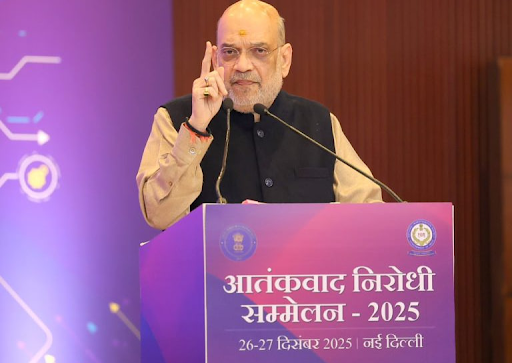Description
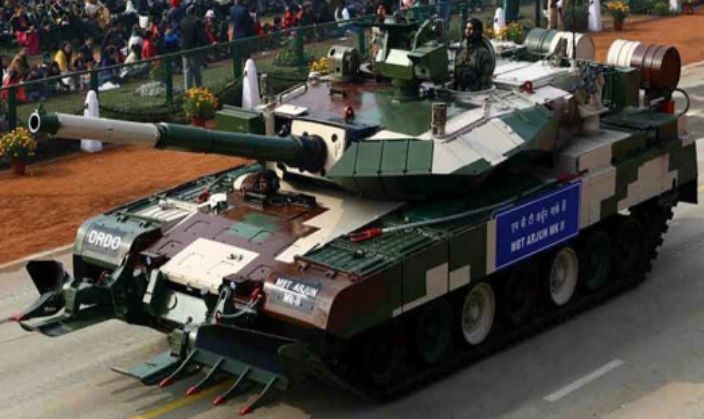
Disclaimer: Copyright infringement not intended.
Context
- The country’s defence exports touched an all-time high of ₹15,920 crore in the financial year 2022-23, Defence Minister Rajnath Singh said.
Details
- This is almost ₹3,000 crore more than the previous financial year’s and a rise of over 10 times since 2016-17, the Defence Ministry said.
- India is now exporting to over 85 countries.
- 100 plus firms are exporting defence products at present.
- India exports major platforms such as Dornier-228, 155 mm Advanced Towed Artillery Guns, BrahMos missiles, Akash surface-to-air missiles, radars, simulators, mine-protected vehicles, armoured vehicles, Pinaka rocket launch systems, ammunition, thermal imagers, body armour and others.
Indian Defence Industry
- The Indian aerospace and defence industry has been estimated at US$ 9.7 billion (Rs 80,000 crores) in 2019-20, with a spurring private sector contribution of US$ 2.05 billion (Rs 17,000 crores).
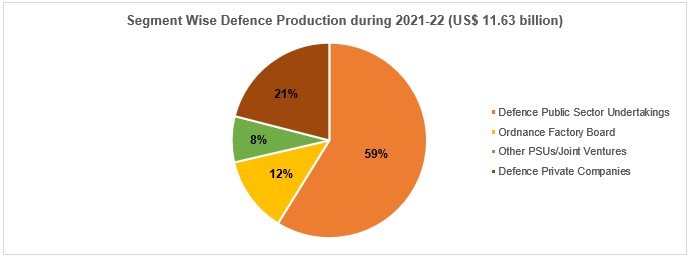
- The Indian defence sector has been growing substantially in recent years due to major government efforts for localisation and enormous revenue expansions, attracting long-term opportunities, partnerships, and capitalising on the synergies in defence and space.
- In order to strengthen the nation’s defensive prowess, the defence sector has undergone major reforms to decrease the expenditure on defence procurement from foreign sources from 46% to 36% in the past four years between 2018-21.
- In the union budget for FY2022-23, the total allocation of capital was enhanced to US$ 18.65 million (Rs 1.52 lakh crores) (~68%), to promote indigenous manufacturing infrastructure supported by requisite research and development ecosystem.
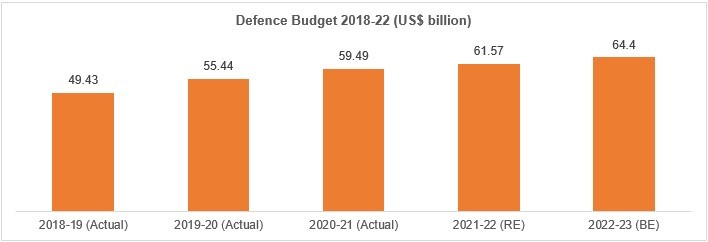
- The government’s persistent efforts in the promotion of Indian defence exports, are steadily marching India from the vision of “Make in India” to “Make for the World”.
- In the last 5 years, defence exports have grown by 334%, reaching a remarkable record of US$ 1.55 billion (Rs 12,815 crores) in the FY2021-22.
- Government of India has set a target of US$ 22 billion (Rs 1.75 lakh crores), including defence exports of US$ 5 billion (Rs 35,000 crore) by the fiscal year 2024-25.
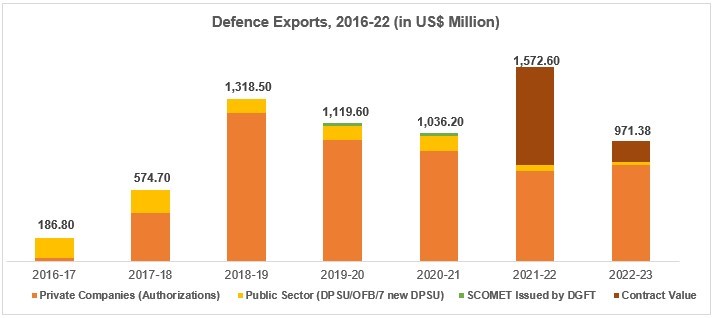
Indian Defence Industry Ecosystem
- India has been one of the world’s largest importers of major arms constituting 11% of the total global market share between 2017-21.
- The government has launched several measures and reforms in the area of defence that is aimed at increasing domestic manufacturing capacity while also encouraging the use of new technology.
- Early in the 2000s, the government permitted 100% private sector participation in defence production with a cap of up to 26% in Foreign Direct Investments (FDI).
- However, this incentive did not ease the accessibility of defence contracts as the Ministry of Defence’s (MoD) (Defence Procurement Procedure) DPP lacked sufficient features to encourage private enterprises' participation.

Government Initiatives
Defence Acquisition Procedure (DAP)- 2020
- It promotes domestic design and production of defence products and considers the fundamental principles of the Aatmanirbhar Bharat Abhiyan.
- The "Make" procedure seeks to indulge in greater consideration for domestic design and production through the following mechanism:
- Make-I (Government-funded): entails the industrial design and development of significant platforms, systems, and pieces of equipment. Up to 70% of the cost of developing a prototype, or a maximum of Rs. 250 crores are provided by Development Agency (DA).
- Make-II (Industry Funded): This programme comprises design and development work as well as creative solutions from Indian vendors. No government financing is provided for these activities, but there is a guarantee of procurement, on the development of a successful prototype.
- Make-III (Indigenously Funded): The equipment may not be developed locally but is manufactured in India using collaboration or with FOEMs or may have entered a joint venture with FOEM.
- The total investments of US$ 2.4 billion (Rs 20,000 crore) are planned in the Defence corridors in each one of the States of Uttar Pradesh and Tamil Nadu by the year 2024.
- Launch of Srijan portal in August 2020, to facilitate indigenisation for DPSUs, OFBs, and to support private players.
Defence Procurement Procedure (DPP)
- A criterion for Indigenous Content (IC) has been established to help Indian component, subsystem, and equipment manufacturers establish themselves in the international defence supply chain.
- Buy Indian-IDDM - (Indigenously Designed, Developed and Manufactured) - means purchase from an Indian vendor with an Indigenous Content (IC) of at least 50%.
- Buy Indian - Buy only from an Indian Vendor. If the design developed is indigenous, then a minimum of 50%: otherwise, 60% if the minimum IC is required.
- Buy Global - Capital procurements bought from foreign or Indian vendors, fall in the category of Government-to-Government deals (G2G)/Inter-Government Agreements (IGA). For a foreign vendor, IC required is nil whereas, for an Indian vendor, at least 30% is required.
- Buy & Make - Capital products procured in a fully formed (FF) state from a foreign vendor followed by indigenous production by an Indian Production Agency (PA), involving Transfer of Technology (ToT). The minimum IC required is 50%.
- Buy and Make (Indian) - Capital products procured in a fully formed (FF) state from an Indian vendor that has connections with foreign OEMs, involving ToT. A Minimum IC required is 50% of ‘make’.

FDI Policy
- Increasing the FDI limit from 49% to 74% under the automatic route in the defence sector.
- Liberalisation of FDI policy would facilitate the ease of doing business.
Offset Policy
- It aims to encourage investments in the Transfer of Technology (ToT)/Critical Technologies to the Indian industry in the Defence sector.
- Technology Development Fund (TDF), initiated by the Defence Research and Development Organisation (DRDO) for faster processing of claims, greater transparency, efficiency and accountability in the process, online audit of offset discharge claims, etc.
Indigenisation list
- It is aimed at helping start-ups, MSMEs, and individual innovators create prototypes and solutions for the problem statements compiled by relevant defence stakeholders.
- The positive indigenisation list encourages MSMEs and start-ups to indulge in developing new technologies from any of the 3 lists, comprising 780 defence platforms, systems and components, announced by the MoD.
Final Say
- The major reforms complement the greater goal of making India an exporter of defence equipment that can compete with the offerings of established global competitors and are a positive step toward enhancing the "Make in India" effort in the defence industry.
- From initially just producing parts to now indigenously producing from scratch, the liberalized private sector players have progressed and expanded.
- India is in a good position to seize the potential export opportunity from the current pool of multi-domain engineering talent, cheap production costs, and friendly connections with the majority of countries.
|
PRACTICE QUESTION
Q) From initially just producing parts to now indigenously producing from scratch, Indian defence industry has progressed and expanded. Do you agree? Justify. (250 words)
|
.jpeg)
https://epaper.thehindu.com/ccidist-ws/th/th_delhi/issues/30911/OPS/GTKB2GR0H.1+G85B2HK4L.1.html









